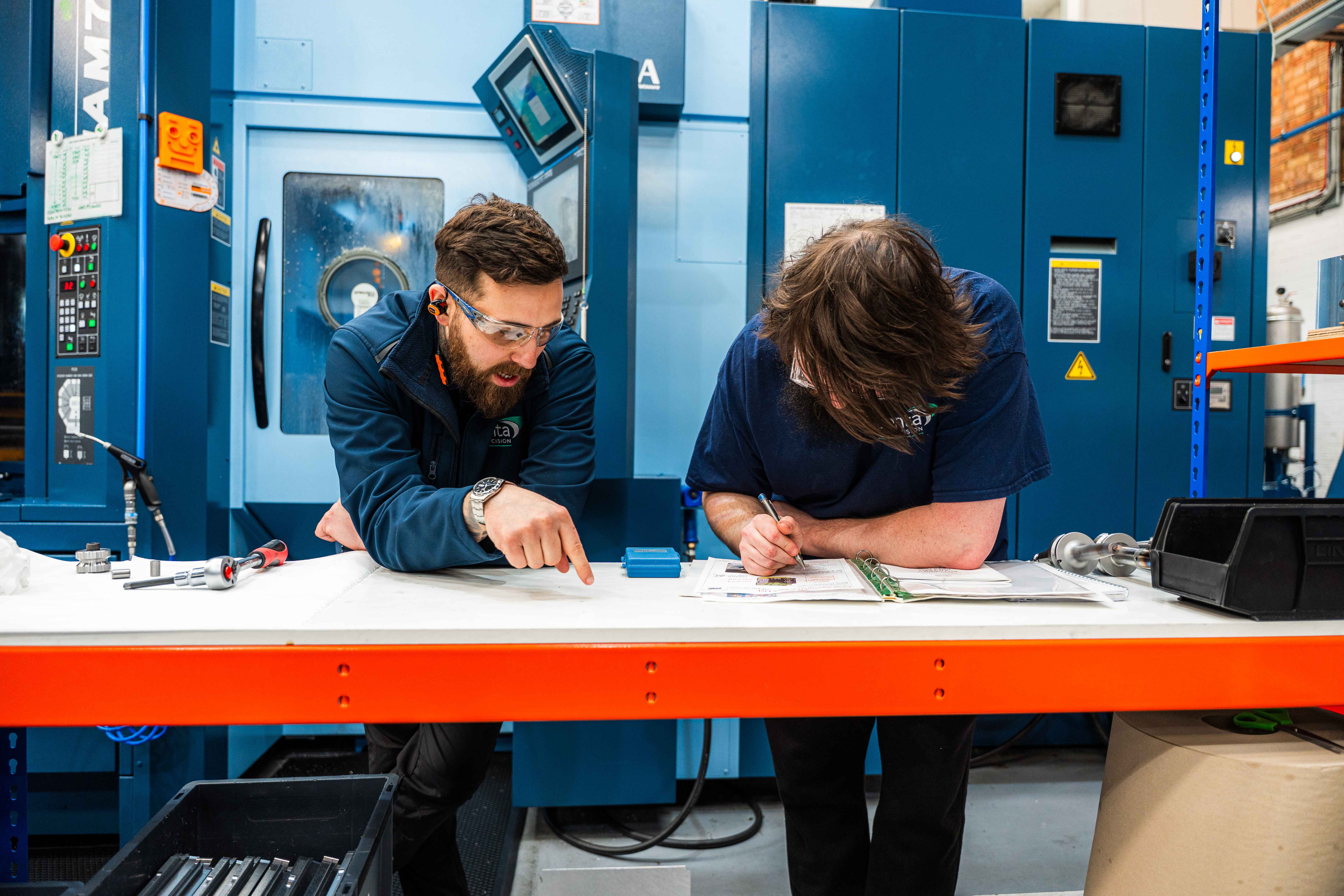 by Mark Walker
by Mark Walker
On-time delivery is not just a nice-to-have in CNC machining. It is the difference between keeping your production line running smoothly and dealing with costly downtime. At Penta Precision, we understand that every missed date creates a chain reaction of delays, budget overruns and unhappy end customers. That is why we have built our entire approach around reducing delivery risk at every stage, from quoting to final dispatch.
In this article, we share the practical, proven measures we take to help procurement teams like yours get the components they need, exactly when they need them. Whether you are sourcing prototypes or high-volume production runs, you will see how strategic planning, disciplined processes and clear communication work together to deliver reliability you can count on.
Need a machining partner who treats your deadlines as non-negotiable? Talk to our team today and find out how Penta Precision can help you keep your supply chain running on time, every time.
Why On‑Time Delivery in CNC Machining Matters to Procurement
On-time delivery is not just a performance metric in CNC machining. For buyers and procurement professionals, it directly affects production flow, customer satisfaction and bottom-line performance. If your machining supplier misses a date, the consequences can be far-reaching, from stalled production lines to missed contract commitments.
A reliable machining partner does more than produce accurate parts. They actively manage the risks that can delay delivery and communicate openly so that you can plan with confidence.
Modern supply chains, real-world delays, and your production risk
Supply chains today are more complex than at any time in recent history. Raw materials may be sourced internationally, parts may move through multiple facilities for machining and finishing, and logistics networks are under pressure from fluctuating demand. Every link in the chain introduces potential for delay.
Understanding these risks and working with a supplier who anticipates them is essential. A delay at any stage can cause a domino effect that disrupts your own delivery promises.
Control what you can: the “serenity” mindset for operations
No business can control every factor in a modern supply chain. Weather events, transport disruptions and supplier setbacks are unavoidable. What can be controlled is the internal process, scheduling discipline and the speed at which problems are spotted and addressed.
At Penta Precision, this mindset drives how we plan, prioritise and communicate, ensuring that risks are managed before they threaten delivery dates.

Pricing and Quoting Done Right (and Why It Changes Your Lead Time)
A job's delivery performance starts at the quoting stage. If the quote is incomplete or overly optimistic, the schedule is compromised before the first cut is made. Correctly understanding the part's features, tolerances, materials and finishing requirements is the foundation for accurate delivery promises.
For procurement professionals, this stage is critical. A quote that has not been built on thorough engineering review is a warning sign. If the supplier has not factored in subcontract lead times, availability of specialist tooling or the time required for inspection and certification, there is a real risk the promised date will slip.
The risk of inattentive quoting and “price-only” emails
When a quote is issued without full review, important details can be missed. A price-only response might seem efficient, but it often ignores the complexity of the work. For example, a tight tolerance on an obscure feature could require a custom fixture, or an unusual finish might involve a specialist subcontractor. Each of these can significantly alter the lead time, yet none may be reflected in a bare-bones quote.
Penta’s evidence-based quoting workflow
We approach quoting as an engineering process, not a sales formality. Drawings are reviewed in detail to identify tolerances, material grades, finishing requirements and any potential manufacturing challenges. We liaise with material suppliers and subcontract finishers to confirm availability and lead times before committing to a delivery date.
Every job is routed through our planning system with calculated cycle times, which are then checked against our live production schedule. This ensures that the date on your order acknowledgement reflects what we can actually achieve, not what we hope to achieve.
Order Processing and Planning You Can Trust
Once a job is confirmed, it must be processed and planned with precision to protect the delivery date. Without robust systems, even the most accurate quote can be undermined by poor scheduling or miscommunication.
The planning stage is where your supplier decides the order of work, the allocation of machine time and the preparation of resources. A disciplined approach here ensures jobs progress logically and without unnecessary delay.
Common planning pitfalls (whiteboards, tee cards, spreadsheets)
Some workshops still rely on outdated methods such as manual whiteboards, paper job cards or fragmented spreadsheets. While these may work in small, low-mix environments, they create problems in busy subcontract shops. Orders can be mislaid, updates are not visible in real-time and changes in priority can cause confusion.
Master scheduling, finite loading, and slack capacity
We use a centralised, live master schedule that is updated daily. All jobs are loaded into the schedule with realistic timescales and resource allocation. We deliberately maintain a margin of unused capacity to allow for urgent orders, late material arrivals or unexpected downtime. This approach might look less "busy" on paper, but it is far more effective for hitting delivery dates in a real manufacturing environment.
Running Live Orders Without the Chaos
Managing work in progress demands visibility and coordination across the shop floor, scheduling and customer service teams. Without this alignment, jobs can slow down or stall without anyone realising until it is too late.
Runway for machinists, daily huddles, and rolling output reporting
We make sure every machinist has a clear understanding of what is coming next, with a 7 to 14-day forward view of their workload. Daily huddles within departments help flag potential issues early, while a cross-functional meeting brings together production, planning and account management to keep all priorities aligned.
A rolling output report is maintained and shared, giving us an accurate picture of progress and enabling us to respond quickly to any customer queries.

Standardisation and Cross-Training to Build Flexibility
A consistent approach to setups and operations is essential for efficiency. Standardisation allows jobs to run smoothly regardless of who is operating the machine, and it ensures that best practices are consistently applied.
From a procurement perspective, this means you are not reliant on a single operator's availability or knowledge. Your job can be completed on time because more than one person is capable of setting up and running it to the required standard.
Reducing variation from personal preferences
When machinists each have their own setup style, changeovers take longer and there is greater scope for error. Personal preferences in tooling, workholding or programming methods can lead to inconsistency.
If the preferred operator is away, another machinist may have to spend valuable time figuring out the setup before starting work. By reducing these variations, we eliminate wasted time and protect delivery schedules.
Templates, standard tooling, and cross-trained teams
We maintain standardised CAD/CAM templates that define programming approaches, tool libraries and workholding methods. Our tooling is organised and consistent across machines, which simplifies setup and reduces downtime. Cross-training ensures machinists are capable of running multiple machine types and processes.
This flexibility means we can adapt to scheduling changes without leaving machines idle or pushing jobs back.
Managing Subcontractors and Special Processes Upstream
Any job that involves subcontract processes is at risk of delays outside the machining supplier’s direct control. However, with the right approach, these risks can be significantly reduced.
We treat subcontract management as a core part of the manufacturing process. The aim is to ensure that once parts leave our premises for finishing, they return on time and to specification, ready for final inspection and shipment.
Why finishing partners delay dispatch and how to prevent it
Finishing operations such as anodising, painting or plating often work on their own schedules, which may not align with yours. Parts may wait in a queue, require transport arrangements or be returned with quality issues that need rework. Each of these adds time and complexity to the delivery process. By building in realistic time allowances and maintaining regular contact with our partners, we prevent most of these issues from becoming last-minute surprises.
The documentation trail: POs, confirmations, booking-in, returns
We issue clear, detailed purchase orders to subcontractors, outlining specifications, agreed lead times and inspection requirements. Order acknowledgements are chased promptly, and we monitor progress throughout. If issues arise, we act quickly to resolve them, whether that means booking a return, reworking parts or adjusting the schedule to accommodate the delay without missing your delivery date.
Quality Without Shortcuts
Quality control directly affects delivery performance. If issues are not caught early, they can lead to rework or scrap at the final stage, putting the delivery date at risk.
Our approach is to identify and address problems as soon as they arise, keeping jobs on track and customers informed.
Independent inspection, NCRs, and 8D root-cause learning
Independent inspection means that parts are checked by someone other than the machinist, providing a fresh set of eyes. This reduces the risk of overlooking an issue due to familiarity. When non-conformances are found, we log them in a formal report and use the 8D problem-solving method to investigate the root cause. This structured approach prevents repeat issues and strengthens our processes over time.
Paperwork, Packaging and Logistics — Small Things, Big Delays
Delays are not always caused by machining or finishing problems. Missing paperwork or incorrect packaging can stop parts from leaving the building, even when they are otherwise ready to ship.
We treat paperwork and packaging as part of the manufacturing process, not an afterthought.
Delivery documentation, special packing, and courier control
At the quoting stage, we confirm what documentation you require, whether that is certificates of conformity, material certificates, FAIRs, PPAP reports or specific delivery notes. We plan packaging to protect parts in transit, using anti-static bags, foam inserts or custom crates as needed. Couriers are booked in advance, with tracking provided so you know when to expect delivery.

Finance and Invoicing Can Delay Dispatch (Here’s How to Avoid It)
Payment terms and account status can be an overlooked delivery risk. If payment is required before dispatch and is not received in time, parts will not leave the premises, regardless of how urgent they are.
Pro-forma and on-stop accounts: keeping parts flowing
We discuss payment terms during onboarding so that both sides understand the process. Our accounts team monitors payment status daily and communicates with customers in advance if action is needed to keep an order on track. This proactive approach prevents finance-related delays from becoming last-minute problems.
Capacity, Buffers and the High-Mix Reality
The nature of high-mix, low-volume machining means that unexpected issues are inevitable. Machine breakdowns, urgent orders, supplier delays and absenteeism all happen from time to time. Without capacity buffers, even minor issues can push back multiple delivery dates.
Why planned “slack” beats chasing 100% utilisation
We deliberately keep some capacity unallocated so that we can respond to unforeseen events without missing deadlines. This “planned slack” might seem counterintuitive, but it is far more effective for maintaining on-time delivery in the real world than running at maximum capacity with no room to manoeuvre.
Data, Feedback and Continuous Improvement
Every job is an opportunity to improve. By capturing data on actual production times, quality issues and scheduling performance, we make our systems more accurate and efficient over time.
Closed-loop learning and the Johari window
We analyse the differences between estimated and actual performance to refine future quotes and schedules. Using the Johari window concept, we work to uncover unknowns early in the process, whether they are on our side, the customer’s or a subcontractor’s. Making potential issues visible before they cause disruption is one of the simplest and most effective ways to protect delivery dates.
Buyer’s Quick-Start Checklist (Practical Actions Today)
A reliable machining supply starts with proactive steps from the buyer. Here is a checklist to reduce delivery risk from the start:
-
Share actual need dates and flexibility upfront
-
Ensure the quote considered tolerances, materials, finishing, tooling and inspection
-
Check that the delivery date is based on a live schedule
-
Provide paperwork and packaging requirements early
-
Understand subcontractor lead times and confirmation processes
-
Agree communication checkpoints
-
Settle payment terms to avoid finance delays
-
Ask about quality control and prevention measures
-
Confirm the supplier uses standardisation and cross-training
How Penta Onboards Procurement Teams for Predictable Supply
Our onboarding process is designed to identify and remove delivery risks. We review all specifications and requirements, quote against a live schedule, and prepare jobs thoroughly before machining begins. Independent inspections during and after machining, active subcontractor management, and finance coordination all contribute to reliable, on-time delivery.
Partnering for Reliable CNC Machining Delivery
Consistent on-time delivery in CNC machining is achieved through disciplined planning, transparent communication and proactive risk management. At Penta Precision, we take responsibility for the factors we can control and plan realistically for those we cannot. This is how we keep your supply chain running and your projects on track.
If you are ready to work with a machining partner who treats your deadlines as non-negotiable, we would like to hear from you. Contact our team today to discuss your upcoming projects, request a quote, or arrange a call to see how we can help you remove delivery risk from your supply chain.